Corporate and Financial Accounting: Takeover Decision & Consolidation
VerifiedAdded on 2023/03/23
|12
|3555
|38
Report
AI Summary
This report provides an understanding of accounting aspects related to the acquisition of FAB Limited by JKY Limited. It assesses how accounting treatments, especially concerning non-controlling interests and consolidation accounting, vary across accounting standards. The report elaborates on the methodological differences between equity accounting and consolidation accounting, focusing on recognition principles and measurement bases. It also examines the treatment of intra-group transactions in consolidated financial statements, highlighting significant variations. Furthermore, the report evaluates the impact of disclosure requirements for non-controlling interests as a distinct item in consolidated financial reports, affecting the overall consolidation process. Desklib is a platform where you can find past papers and solved assignments for students.
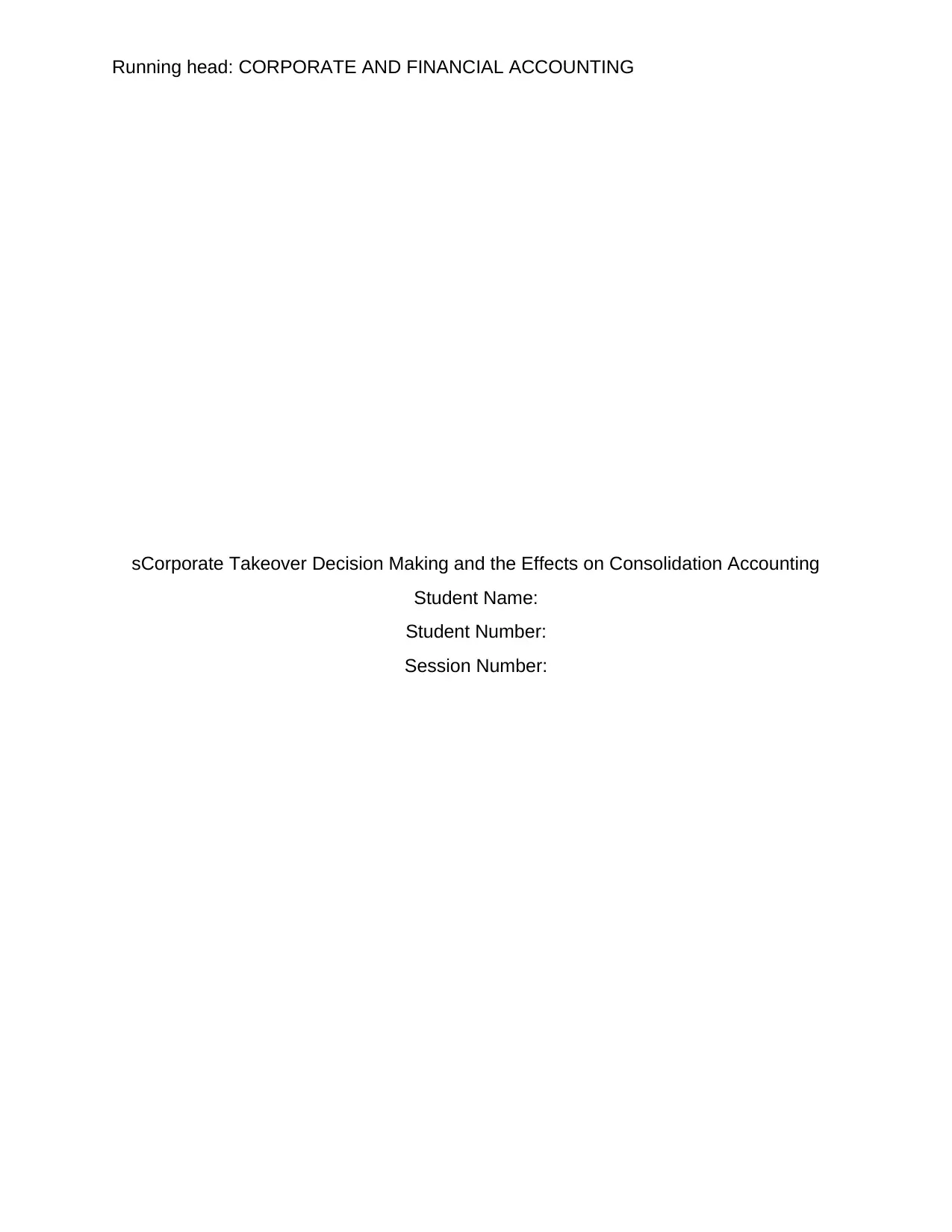
Running head: CORPORATE AND FINANCIAL ACCOUNTING
sCorporate Takeover Decision Making and the Effects on Consolidation Accounting
Student Name:
Student Number:
Session Number:
sCorporate Takeover Decision Making and the Effects on Consolidation Accounting
Student Name:
Student Number:
Session Number:
Paraphrase This Document
Need a fresh take? Get an instant paraphrase of this document with our AI Paraphraser
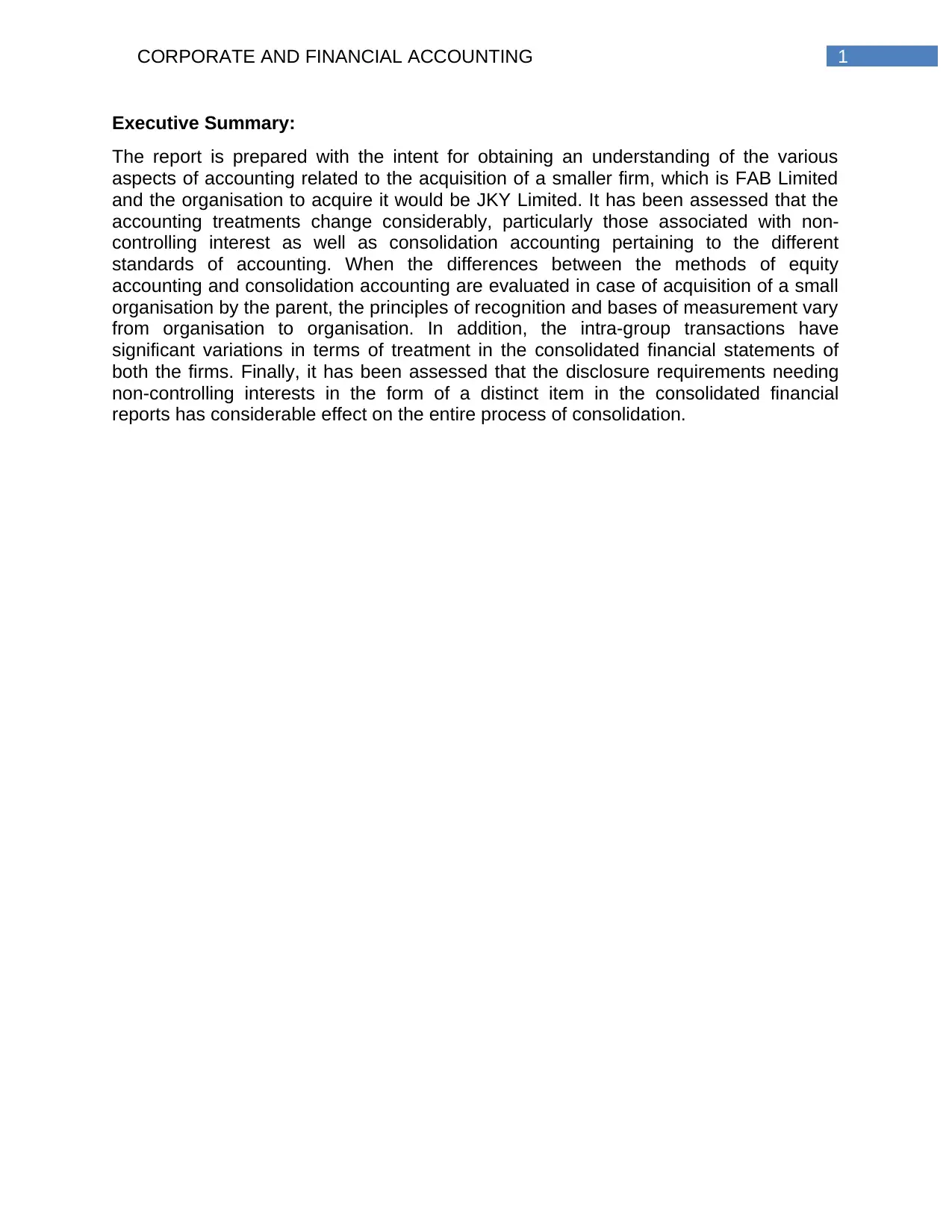
1CORPORATE AND FINANCIAL ACCOUNTING
Executive Summary:
The report is prepared with the intent for obtaining an understanding of the various
aspects of accounting related to the acquisition of a smaller firm, which is FAB Limited
and the organisation to acquire it would be JKY Limited. It has been assessed that the
accounting treatments change considerably, particularly those associated with non-
controlling interest as well as consolidation accounting pertaining to the different
standards of accounting. When the differences between the methods of equity
accounting and consolidation accounting are evaluated in case of acquisition of a small
organisation by the parent, the principles of recognition and bases of measurement vary
from organisation to organisation. In addition, the intra-group transactions have
significant variations in terms of treatment in the consolidated financial statements of
both the firms. Finally, it has been assessed that the disclosure requirements needing
non-controlling interests in the form of a distinct item in the consolidated financial
reports has considerable effect on the entire process of consolidation.
Executive Summary:
The report is prepared with the intent for obtaining an understanding of the various
aspects of accounting related to the acquisition of a smaller firm, which is FAB Limited
and the organisation to acquire it would be JKY Limited. It has been assessed that the
accounting treatments change considerably, particularly those associated with non-
controlling interest as well as consolidation accounting pertaining to the different
standards of accounting. When the differences between the methods of equity
accounting and consolidation accounting are evaluated in case of acquisition of a small
organisation by the parent, the principles of recognition and bases of measurement vary
from organisation to organisation. In addition, the intra-group transactions have
significant variations in terms of treatment in the consolidated financial statements of
both the firms. Finally, it has been assessed that the disclosure requirements needing
non-controlling interests in the form of a distinct item in the consolidated financial
reports has considerable effect on the entire process of consolidation.
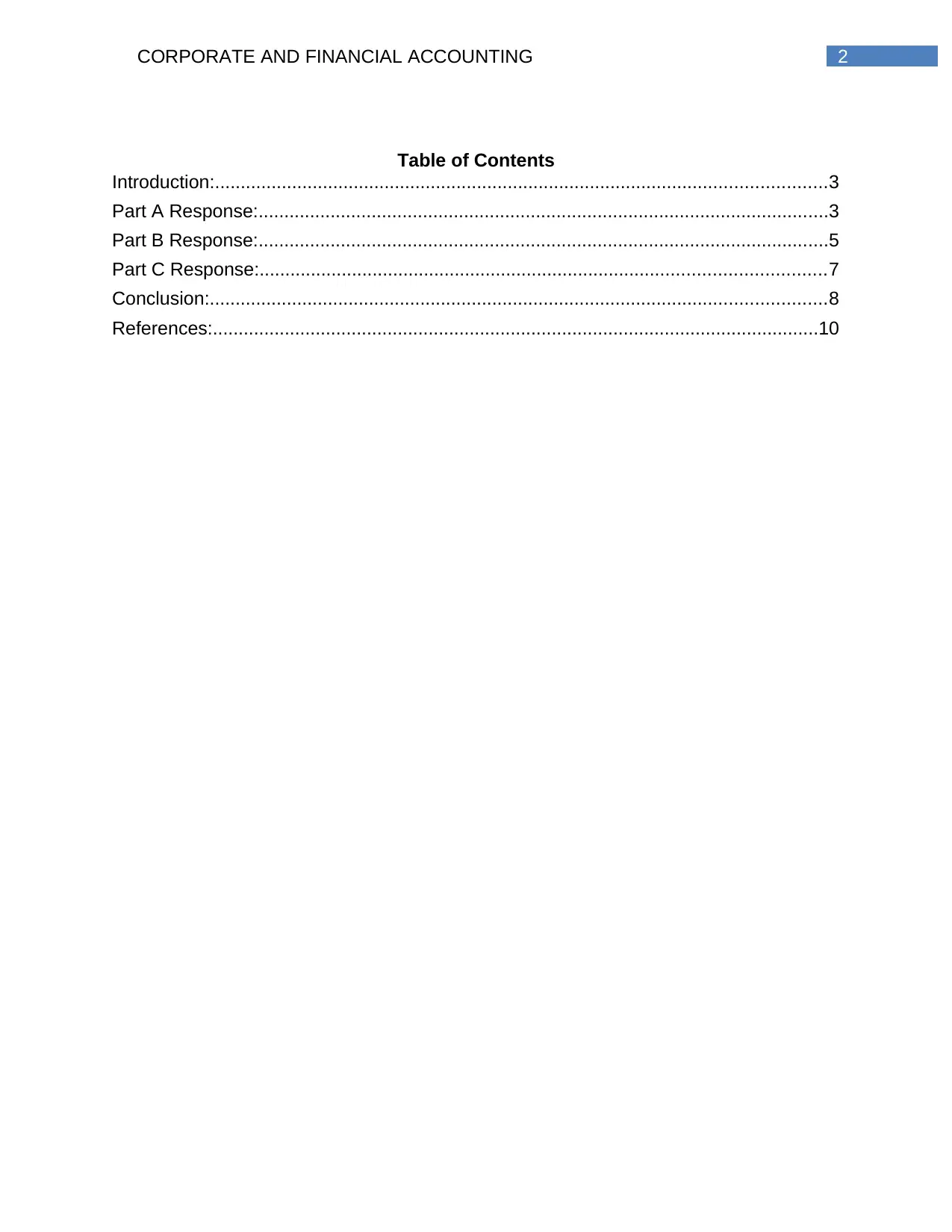
2CORPORATE AND FINANCIAL ACCOUNTING
Table of Contents
Introduction:.......................................................................................................................3
Part A Response:...............................................................................................................3
Part B Response:...............................................................................................................5
Part C Response:..............................................................................................................7
Conclusion:........................................................................................................................8
References:......................................................................................................................10
Table of Contents
Introduction:.......................................................................................................................3
Part A Response:...............................................................................................................3
Part B Response:...............................................................................................................5
Part C Response:..............................................................................................................7
Conclusion:........................................................................................................................8
References:......................................................................................................................10
⊘ This is a preview!⊘
Do you want full access?
Subscribe today to unlock all pages.

Trusted by 1+ million students worldwide
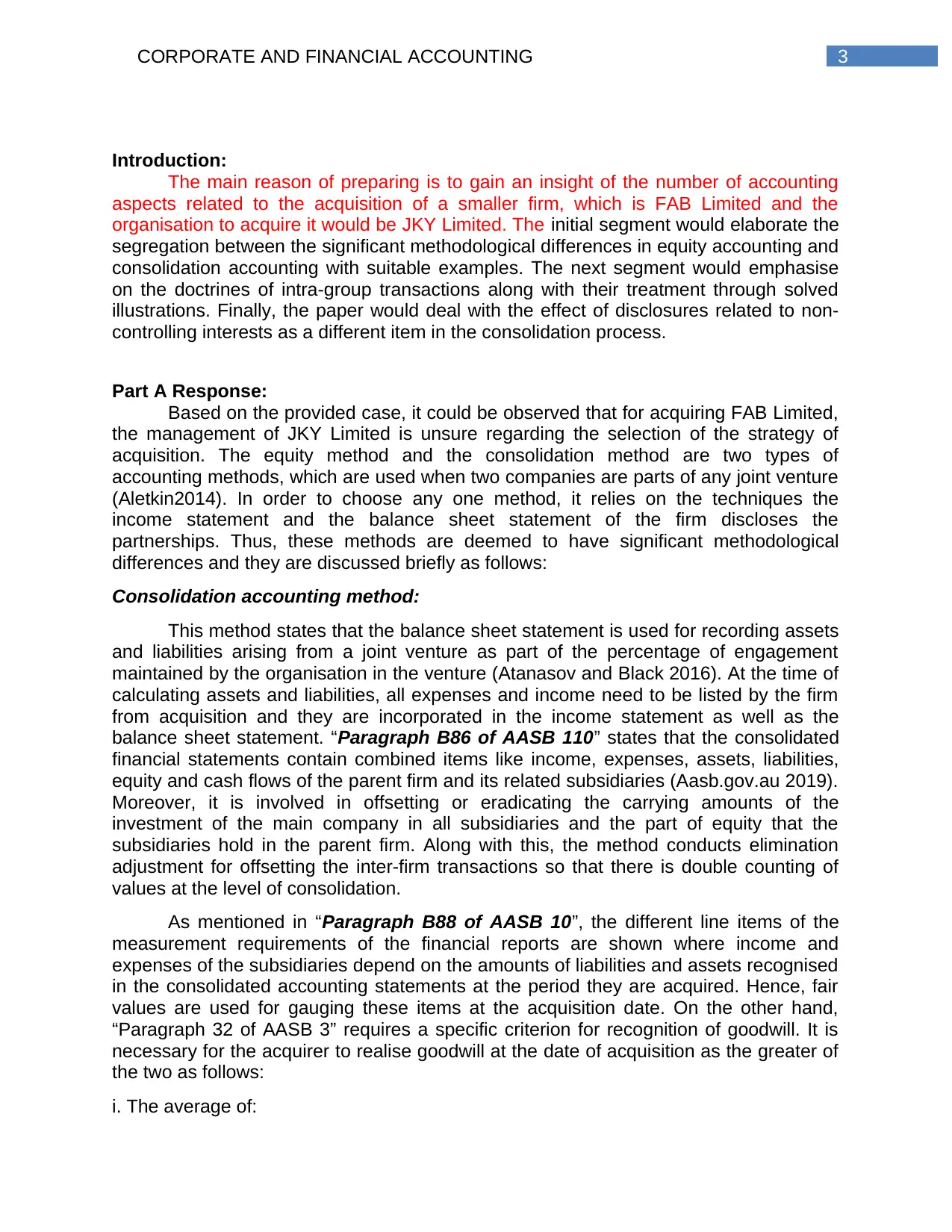
3CORPORATE AND FINANCIAL ACCOUNTING
Introduction:
The main reason of preparing is to gain an insight of the number of accounting
aspects related to the acquisition of a smaller firm, which is FAB Limited and the
organisation to acquire it would be JKY Limited. The initial segment would elaborate the
segregation between the significant methodological differences in equity accounting and
consolidation accounting with suitable examples. The next segment would emphasise
on the doctrines of intra-group transactions along with their treatment through solved
illustrations. Finally, the paper would deal with the effect of disclosures related to non-
controlling interests as a different item in the consolidation process.
Part A Response:
Based on the provided case, it could be observed that for acquiring FAB Limited,
the management of JKY Limited is unsure regarding the selection of the strategy of
acquisition. The equity method and the consolidation method are two types of
accounting methods, which are used when two companies are parts of any joint venture
(Aletkin2014). In order to choose any one method, it relies on the techniques the
income statement and the balance sheet statement of the firm discloses the
partnerships. Thus, these methods are deemed to have significant methodological
differences and they are discussed briefly as follows:
Consolidation accounting method:
This method states that the balance sheet statement is used for recording assets
and liabilities arising from a joint venture as part of the percentage of engagement
maintained by the organisation in the venture (Atanasov and Black 2016). At the time of
calculating assets and liabilities, all expenses and income need to be listed by the firm
from acquisition and they are incorporated in the income statement as well as the
balance sheet statement. “Paragraph B86 of AASB 110” states that the consolidated
financial statements contain combined items like income, expenses, assets, liabilities,
equity and cash flows of the parent firm and its related subsidiaries (Aasb.gov.au 2019).
Moreover, it is involved in offsetting or eradicating the carrying amounts of the
investment of the main company in all subsidiaries and the part of equity that the
subsidiaries hold in the parent firm. Along with this, the method conducts elimination
adjustment for offsetting the inter-firm transactions so that there is double counting of
values at the level of consolidation.
As mentioned in “Paragraph B88 of AASB 10”, the different line items of the
measurement requirements of the financial reports are shown where income and
expenses of the subsidiaries depend on the amounts of liabilities and assets recognised
in the consolidated accounting statements at the period they are acquired. Hence, fair
values are used for gauging these items at the acquisition date. On the other hand,
“Paragraph 32 of AASB 3” requires a specific criterion for recognition of goodwill. It is
necessary for the acquirer to realise goodwill at the date of acquisition as the greater of
the two as follows:
i. The average of:
Introduction:
The main reason of preparing is to gain an insight of the number of accounting
aspects related to the acquisition of a smaller firm, which is FAB Limited and the
organisation to acquire it would be JKY Limited. The initial segment would elaborate the
segregation between the significant methodological differences in equity accounting and
consolidation accounting with suitable examples. The next segment would emphasise
on the doctrines of intra-group transactions along with their treatment through solved
illustrations. Finally, the paper would deal with the effect of disclosures related to non-
controlling interests as a different item in the consolidation process.
Part A Response:
Based on the provided case, it could be observed that for acquiring FAB Limited,
the management of JKY Limited is unsure regarding the selection of the strategy of
acquisition. The equity method and the consolidation method are two types of
accounting methods, which are used when two companies are parts of any joint venture
(Aletkin2014). In order to choose any one method, it relies on the techniques the
income statement and the balance sheet statement of the firm discloses the
partnerships. Thus, these methods are deemed to have significant methodological
differences and they are discussed briefly as follows:
Consolidation accounting method:
This method states that the balance sheet statement is used for recording assets
and liabilities arising from a joint venture as part of the percentage of engagement
maintained by the organisation in the venture (Atanasov and Black 2016). At the time of
calculating assets and liabilities, all expenses and income need to be listed by the firm
from acquisition and they are incorporated in the income statement as well as the
balance sheet statement. “Paragraph B86 of AASB 110” states that the consolidated
financial statements contain combined items like income, expenses, assets, liabilities,
equity and cash flows of the parent firm and its related subsidiaries (Aasb.gov.au 2019).
Moreover, it is involved in offsetting or eradicating the carrying amounts of the
investment of the main company in all subsidiaries and the part of equity that the
subsidiaries hold in the parent firm. Along with this, the method conducts elimination
adjustment for offsetting the inter-firm transactions so that there is double counting of
values at the level of consolidation.
As mentioned in “Paragraph B88 of AASB 10”, the different line items of the
measurement requirements of the financial reports are shown where income and
expenses of the subsidiaries depend on the amounts of liabilities and assets recognised
in the consolidated accounting statements at the period they are acquired. Hence, fair
values are used for gauging these items at the acquisition date. On the other hand,
“Paragraph 32 of AASB 3” requires a specific criterion for recognition of goodwill. It is
necessary for the acquirer to realise goodwill at the date of acquisition as the greater of
the two as follows:
i. The average of:
Paraphrase This Document
Need a fresh take? Get an instant paraphrase of this document with our AI Paraphraser

4CORPORATE AND FINANCIAL ACCOUNTING
The consideration transfer measured in compliance with AASB 3 needing fair
value at the time the same has been obtained
The amount related to the acquiree’s non-controlling interest gauged as per the
guideline
In case of business combination achieved in phases, the fair value of equity
interest held previously in the acquireee on the part of the acquirer at the fair
value of the date it is acquired
ii. The net of the amounts related to identifiable amounts acquired along with the
projected liabilities in accordance with the standard (Aasb.gov.au 2019)
For instance, an assumption is made that the business has been commenced by
JKY Limited on 1/5/2018 where there is investment amount of $20,000,000. The
following journal entry is passed below:
After one year, an investment amount of $10,000,000 has been made by JKY
Limited for purchasing all shares of FAB Limited. Under such situation, the following
journal entry would be passed:
As a result, JKY Limited would have cash balance of $10,000,000, while the
asset would be $20,000,000. The transaction would be disclosed in the books of FAB
Limited as follows:
At the end of the accounting year, the consolidated financial statement would be
represented as follows:
The consideration transfer measured in compliance with AASB 3 needing fair
value at the time the same has been obtained
The amount related to the acquiree’s non-controlling interest gauged as per the
guideline
In case of business combination achieved in phases, the fair value of equity
interest held previously in the acquireee on the part of the acquirer at the fair
value of the date it is acquired
ii. The net of the amounts related to identifiable amounts acquired along with the
projected liabilities in accordance with the standard (Aasb.gov.au 2019)
For instance, an assumption is made that the business has been commenced by
JKY Limited on 1/5/2018 where there is investment amount of $20,000,000. The
following journal entry is passed below:
After one year, an investment amount of $10,000,000 has been made by JKY
Limited for purchasing all shares of FAB Limited. Under such situation, the following
journal entry would be passed:
As a result, JKY Limited would have cash balance of $10,000,000, while the
asset would be $20,000,000. The transaction would be disclosed in the books of FAB
Limited as follows:
At the end of the accounting year, the consolidated financial statement would be
represented as follows:
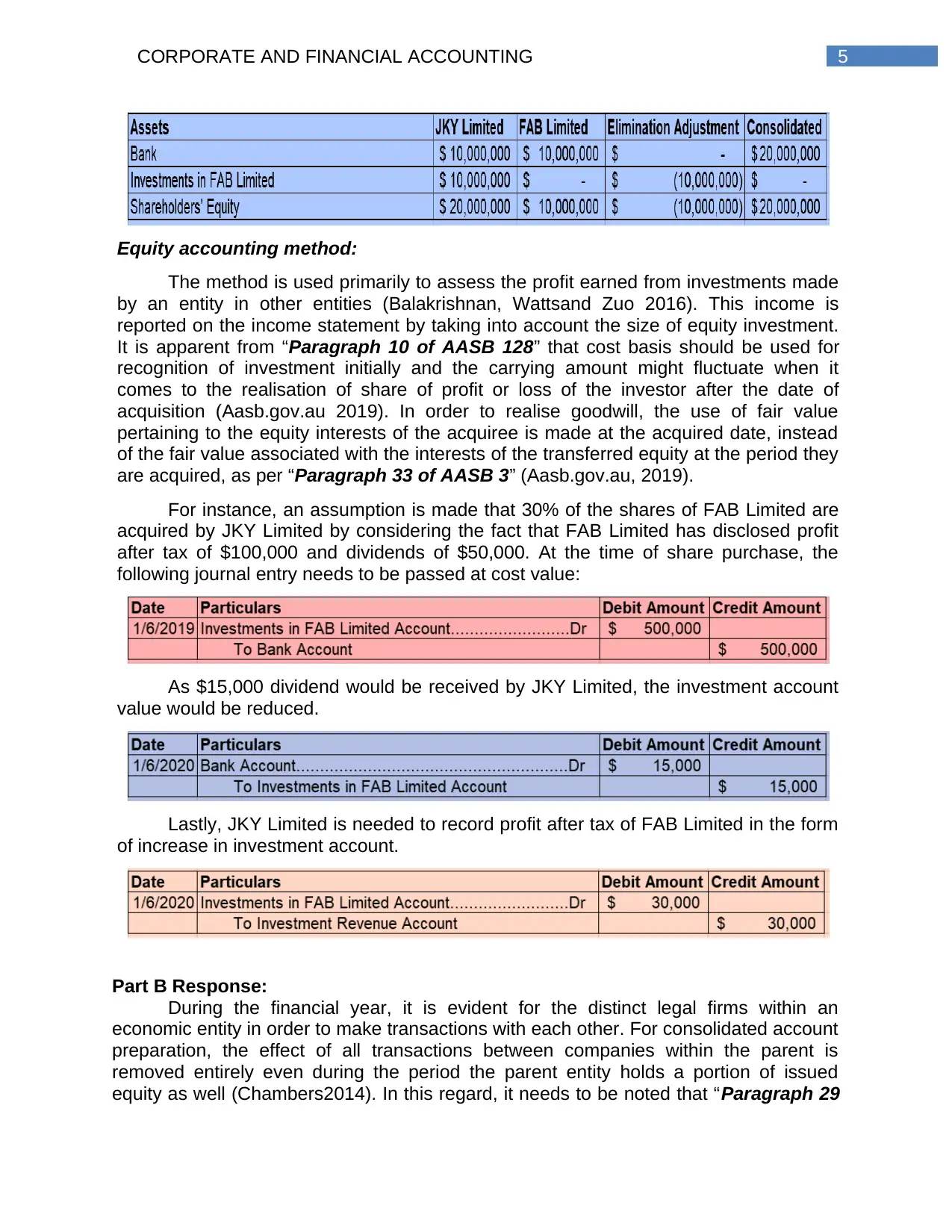
5CORPORATE AND FINANCIAL ACCOUNTING
Equity accounting method:
The method is used primarily to assess the profit earned from investments made
by an entity in other entities (Balakrishnan, Wattsand Zuo 2016). This income is
reported on the income statement by taking into account the size of equity investment.
It is apparent from “Paragraph 10 of AASB 128” that cost basis should be used for
recognition of investment initially and the carrying amount might fluctuate when it
comes to the realisation of share of profit or loss of the investor after the date of
acquisition (Aasb.gov.au 2019). In order to realise goodwill, the use of fair value
pertaining to the equity interests of the acquiree is made at the acquired date, instead
of the fair value associated with the interests of the transferred equity at the period they
are acquired, as per “Paragraph 33 of AASB 3” (Aasb.gov.au, 2019).
For instance, an assumption is made that 30% of the shares of FAB Limited are
acquired by JKY Limited by considering the fact that FAB Limited has disclosed profit
after tax of $100,000 and dividends of $50,000. At the time of share purchase, the
following journal entry needs to be passed at cost value:
As $15,000 dividend would be received by JKY Limited, the investment account
value would be reduced.
Lastly, JKY Limited is needed to record profit after tax of FAB Limited in the form
of increase in investment account.
Part B Response:
During the financial year, it is evident for the distinct legal firms within an
economic entity in order to make transactions with each other. For consolidated account
preparation, the effect of all transactions between companies within the parent is
removed entirely even during the period the parent entity holds a portion of issued
equity as well (Chambers2014). In this regard, it needs to be noted that “Paragraph 29
Equity accounting method:
The method is used primarily to assess the profit earned from investments made
by an entity in other entities (Balakrishnan, Wattsand Zuo 2016). This income is
reported on the income statement by taking into account the size of equity investment.
It is apparent from “Paragraph 10 of AASB 128” that cost basis should be used for
recognition of investment initially and the carrying amount might fluctuate when it
comes to the realisation of share of profit or loss of the investor after the date of
acquisition (Aasb.gov.au 2019). In order to realise goodwill, the use of fair value
pertaining to the equity interests of the acquiree is made at the acquired date, instead
of the fair value associated with the interests of the transferred equity at the period they
are acquired, as per “Paragraph 33 of AASB 3” (Aasb.gov.au, 2019).
For instance, an assumption is made that 30% of the shares of FAB Limited are
acquired by JKY Limited by considering the fact that FAB Limited has disclosed profit
after tax of $100,000 and dividends of $50,000. At the time of share purchase, the
following journal entry needs to be passed at cost value:
As $15,000 dividend would be received by JKY Limited, the investment account
value would be reduced.
Lastly, JKY Limited is needed to record profit after tax of FAB Limited in the form
of increase in investment account.
Part B Response:
During the financial year, it is evident for the distinct legal firms within an
economic entity in order to make transactions with each other. For consolidated account
preparation, the effect of all transactions between companies within the parent is
removed entirely even during the period the parent entity holds a portion of issued
equity as well (Chambers2014). In this regard, it needs to be noted that “Paragraph 29
⊘ This is a preview!⊘
Do you want full access?
Subscribe today to unlock all pages.

Trusted by 1+ million students worldwide

6CORPORATE AND FINANCIAL ACCOUNTING
of AASB 127” needs intra-group transactions, balances, income and expenses to be
removed entirely (Legislation.gov.au 2019). Some examples of these types of
transactions primarily constitute of the following:
Payment of management fees to a group member
Payment of dividends to the group members
Sale of intra-group inventory
Sale of non-current assets of intra-group
Loans of intra-group
The adjustments of consolidation pertaining to intra-group transactions remove such
transactions through real accounting entry reversal made so that it is possible to realise
transactions in distinct legal firms (Cîrstea 2014).
From the provided case, it has been identified that inventory was bought by JKY
Limited from a partially owned subsidiary. Therefore, the group could not recognise
revenue until inventory is sold to the outside parties. As a result, elimination of
unrecognised profits is required from the consolidated accounts (Flower 2018). The
occurrence of unrecognised inventory is evident from inventory sale within the group in
order to earn profit that is hold until the end of the period. As mentioned in “Paragraph
25 of AASB 127”, any profit or loss from intra-group transactions realised in inventory
and non-current assets have to be removed completely.
Based on the given information, a partially owned subsidiary of JKY Limited is
assumed to have sold inventory to JKY Limited, which constitutes of mark-up as well. At
the time JKY Limited sells inventory to the outside customers, it is correct from the
viewpoint of group transactions (Hoyle, Schaefer and Doupnik 2015). However, until
JKY Limited sells products to the outside customers, the profit realised by subsidiary on
inventory sold to JKY Limited would result in unrecognised profit, which would result in
undue increase in group profit. Therefore, the unrecognised profit needs to be
eliminated accordingly. For example, it is estimated that inventory has been bought by
JKY Limited from the subsidiary for $12,500, which is retained at the end of the period.
Additional assumption is made that 25% margin is to be earned by the subsidiary and
hence, profit on inventory balance is obtained as $2,500 ($12,500 * 25/125). This would
lead to overstated consolidated profit by $2,500 due to which adjustment entry needs to
be passed as follows:
At the time the subsidiary sells goods having non-controlling interest within the
group, there is a requirement to decrease the overall unrealised profit. This increases
doubt concerning the profit that is to be reported for the non-controlling interests. The
initial initiative is to assign to certain non-controlling interests a portion of share related
with unrecognised profit. For this reason, the overall profit of the selling organisation is
decreased. Another initiative is to consider no portion of unrecognised profit to the non-
controlling interests. Moreover, the non-controlling interest figure indicates share capita
entitlement along with reserves related with the subsidiary (Pacter 2014). For example,
of AASB 127” needs intra-group transactions, balances, income and expenses to be
removed entirely (Legislation.gov.au 2019). Some examples of these types of
transactions primarily constitute of the following:
Payment of management fees to a group member
Payment of dividends to the group members
Sale of intra-group inventory
Sale of non-current assets of intra-group
Loans of intra-group
The adjustments of consolidation pertaining to intra-group transactions remove such
transactions through real accounting entry reversal made so that it is possible to realise
transactions in distinct legal firms (Cîrstea 2014).
From the provided case, it has been identified that inventory was bought by JKY
Limited from a partially owned subsidiary. Therefore, the group could not recognise
revenue until inventory is sold to the outside parties. As a result, elimination of
unrecognised profits is required from the consolidated accounts (Flower 2018). The
occurrence of unrecognised inventory is evident from inventory sale within the group in
order to earn profit that is hold until the end of the period. As mentioned in “Paragraph
25 of AASB 127”, any profit or loss from intra-group transactions realised in inventory
and non-current assets have to be removed completely.
Based on the given information, a partially owned subsidiary of JKY Limited is
assumed to have sold inventory to JKY Limited, which constitutes of mark-up as well. At
the time JKY Limited sells inventory to the outside customers, it is correct from the
viewpoint of group transactions (Hoyle, Schaefer and Doupnik 2015). However, until
JKY Limited sells products to the outside customers, the profit realised by subsidiary on
inventory sold to JKY Limited would result in unrecognised profit, which would result in
undue increase in group profit. Therefore, the unrecognised profit needs to be
eliminated accordingly. For example, it is estimated that inventory has been bought by
JKY Limited from the subsidiary for $12,500, which is retained at the end of the period.
Additional assumption is made that 25% margin is to be earned by the subsidiary and
hence, profit on inventory balance is obtained as $2,500 ($12,500 * 25/125). This would
lead to overstated consolidated profit by $2,500 due to which adjustment entry needs to
be passed as follows:
At the time the subsidiary sells goods having non-controlling interest within the
group, there is a requirement to decrease the overall unrealised profit. This increases
doubt concerning the profit that is to be reported for the non-controlling interests. The
initial initiative is to assign to certain non-controlling interests a portion of share related
with unrecognised profit. For this reason, the overall profit of the selling organisation is
decreased. Another initiative is to consider no portion of unrecognised profit to the non-
controlling interests. Moreover, the non-controlling interest figure indicates share capita
entitlement along with reserves related with the subsidiary (Pacter 2014). For example,
Paraphrase This Document
Need a fresh take? Get an instant paraphrase of this document with our AI Paraphraser
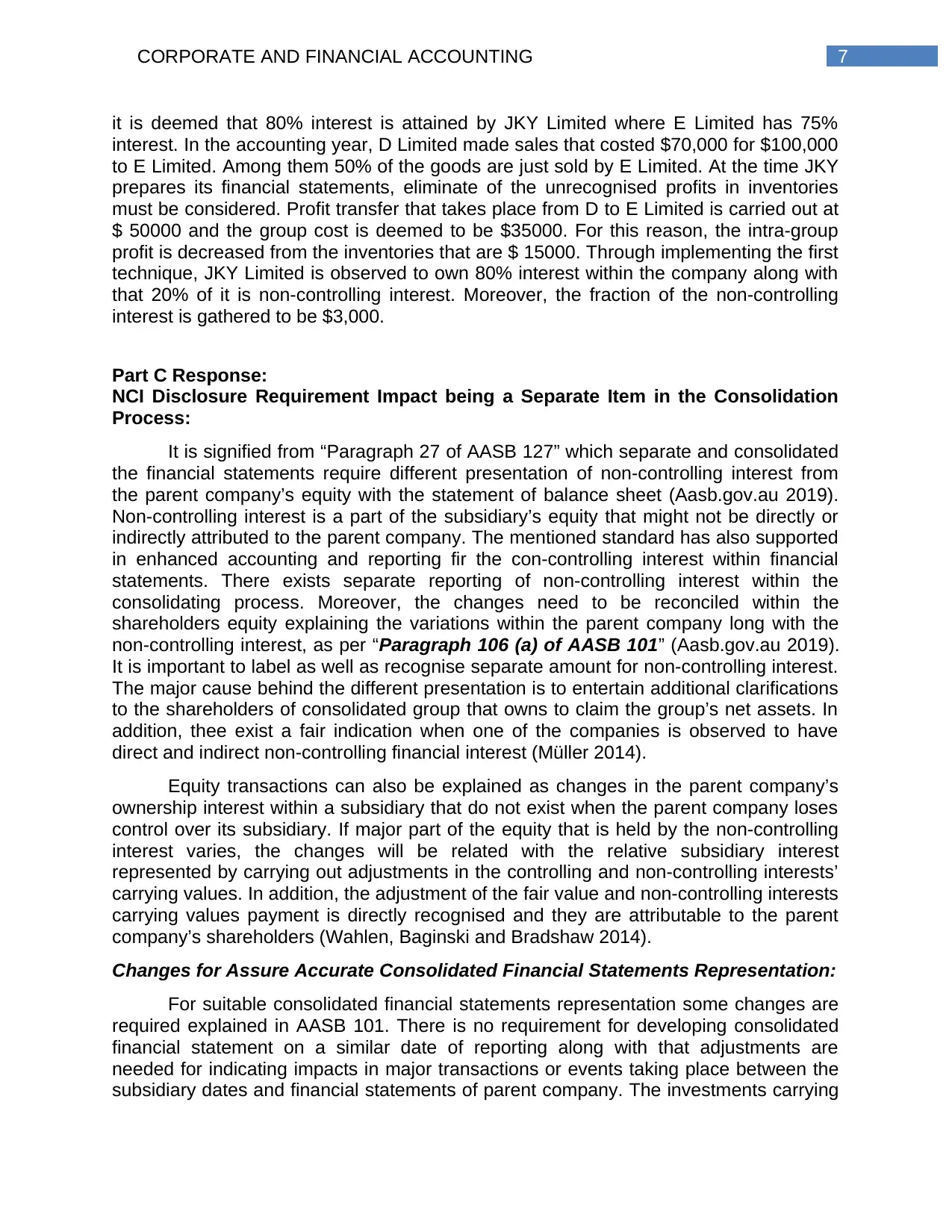
7CORPORATE AND FINANCIAL ACCOUNTING
it is deemed that 80% interest is attained by JKY Limited where E Limited has 75%
interest. In the accounting year, D Limited made sales that costed $70,000 for $100,000
to E Limited. Among them 50% of the goods are just sold by E Limited. At the time JKY
prepares its financial statements, eliminate of the unrecognised profits in inventories
must be considered. Profit transfer that takes place from D to E Limited is carried out at
$ 50000 and the group cost is deemed to be $35000. For this reason, the intra-group
profit is decreased from the inventories that are $ 15000. Through implementing the first
technique, JKY Limited is observed to own 80% interest within the company along with
that 20% of it is non-controlling interest. Moreover, the fraction of the non-controlling
interest is gathered to be $3,000.
Part C Response:
NCI Disclosure Requirement Impact being a Separate Item in the Consolidation
Process:
It is signified from “Paragraph 27 of AASB 127” which separate and consolidated
the financial statements require different presentation of non-controlling interest from
the parent company’s equity with the statement of balance sheet (Aasb.gov.au 2019).
Non-controlling interest is a part of the subsidiary’s equity that might not be directly or
indirectly attributed to the parent company. The mentioned standard has also supported
in enhanced accounting and reporting fir the con-controlling interest within financial
statements. There exists separate reporting of non-controlling interest within the
consolidating process. Moreover, the changes need to be reconciled within the
shareholders equity explaining the variations within the parent company long with the
non-controlling interest, as per “Paragraph 106 (a) of AASB 101” (Aasb.gov.au 2019).
It is important to label as well as recognise separate amount for non-controlling interest.
The major cause behind the different presentation is to entertain additional clarifications
to the shareholders of consolidated group that owns to claim the group’s net assets. In
addition, thee exist a fair indication when one of the companies is observed to have
direct and indirect non-controlling financial interest (Müller 2014).
Equity transactions can also be explained as changes in the parent company’s
ownership interest within a subsidiary that do not exist when the parent company loses
control over its subsidiary. If major part of the equity that is held by the non-controlling
interest varies, the changes will be related with the relative subsidiary interest
represented by carrying out adjustments in the controlling and non-controlling interests’
carrying values. In addition, the adjustment of the fair value and non-controlling interests
carrying values payment is directly recognised and they are attributable to the parent
company’s shareholders (Wahlen, Baginski and Bradshaw 2014).
Changes for Assure Accurate Consolidated Financial Statements Representation:
For suitable consolidated financial statements representation some changes are
required explained in AASB 101. There is no requirement for developing consolidated
financial statement on a similar date of reporting along with that adjustments are
needed for indicating impacts in major transactions or events taking place between the
subsidiary dates and financial statements of parent company. The investments carrying
it is deemed that 80% interest is attained by JKY Limited where E Limited has 75%
interest. In the accounting year, D Limited made sales that costed $70,000 for $100,000
to E Limited. Among them 50% of the goods are just sold by E Limited. At the time JKY
prepares its financial statements, eliminate of the unrecognised profits in inventories
must be considered. Profit transfer that takes place from D to E Limited is carried out at
$ 50000 and the group cost is deemed to be $35000. For this reason, the intra-group
profit is decreased from the inventories that are $ 15000. Through implementing the first
technique, JKY Limited is observed to own 80% interest within the company along with
that 20% of it is non-controlling interest. Moreover, the fraction of the non-controlling
interest is gathered to be $3,000.
Part C Response:
NCI Disclosure Requirement Impact being a Separate Item in the Consolidation
Process:
It is signified from “Paragraph 27 of AASB 127” which separate and consolidated
the financial statements require different presentation of non-controlling interest from
the parent company’s equity with the statement of balance sheet (Aasb.gov.au 2019).
Non-controlling interest is a part of the subsidiary’s equity that might not be directly or
indirectly attributed to the parent company. The mentioned standard has also supported
in enhanced accounting and reporting fir the con-controlling interest within financial
statements. There exists separate reporting of non-controlling interest within the
consolidating process. Moreover, the changes need to be reconciled within the
shareholders equity explaining the variations within the parent company long with the
non-controlling interest, as per “Paragraph 106 (a) of AASB 101” (Aasb.gov.au 2019).
It is important to label as well as recognise separate amount for non-controlling interest.
The major cause behind the different presentation is to entertain additional clarifications
to the shareholders of consolidated group that owns to claim the group’s net assets. In
addition, thee exist a fair indication when one of the companies is observed to have
direct and indirect non-controlling financial interest (Müller 2014).
Equity transactions can also be explained as changes in the parent company’s
ownership interest within a subsidiary that do not exist when the parent company loses
control over its subsidiary. If major part of the equity that is held by the non-controlling
interest varies, the changes will be related with the relative subsidiary interest
represented by carrying out adjustments in the controlling and non-controlling interests’
carrying values. In addition, the adjustment of the fair value and non-controlling interests
carrying values payment is directly recognised and they are attributable to the parent
company’s shareholders (Wahlen, Baginski and Bradshaw 2014).
Changes for Assure Accurate Consolidated Financial Statements Representation:
For suitable consolidated financial statements representation some changes are
required explained in AASB 101. There is no requirement for developing consolidated
financial statement on a similar date of reporting along with that adjustments are
needed for indicating impacts in major transactions or events taking place between the
subsidiary dates and financial statements of parent company. The investments carrying
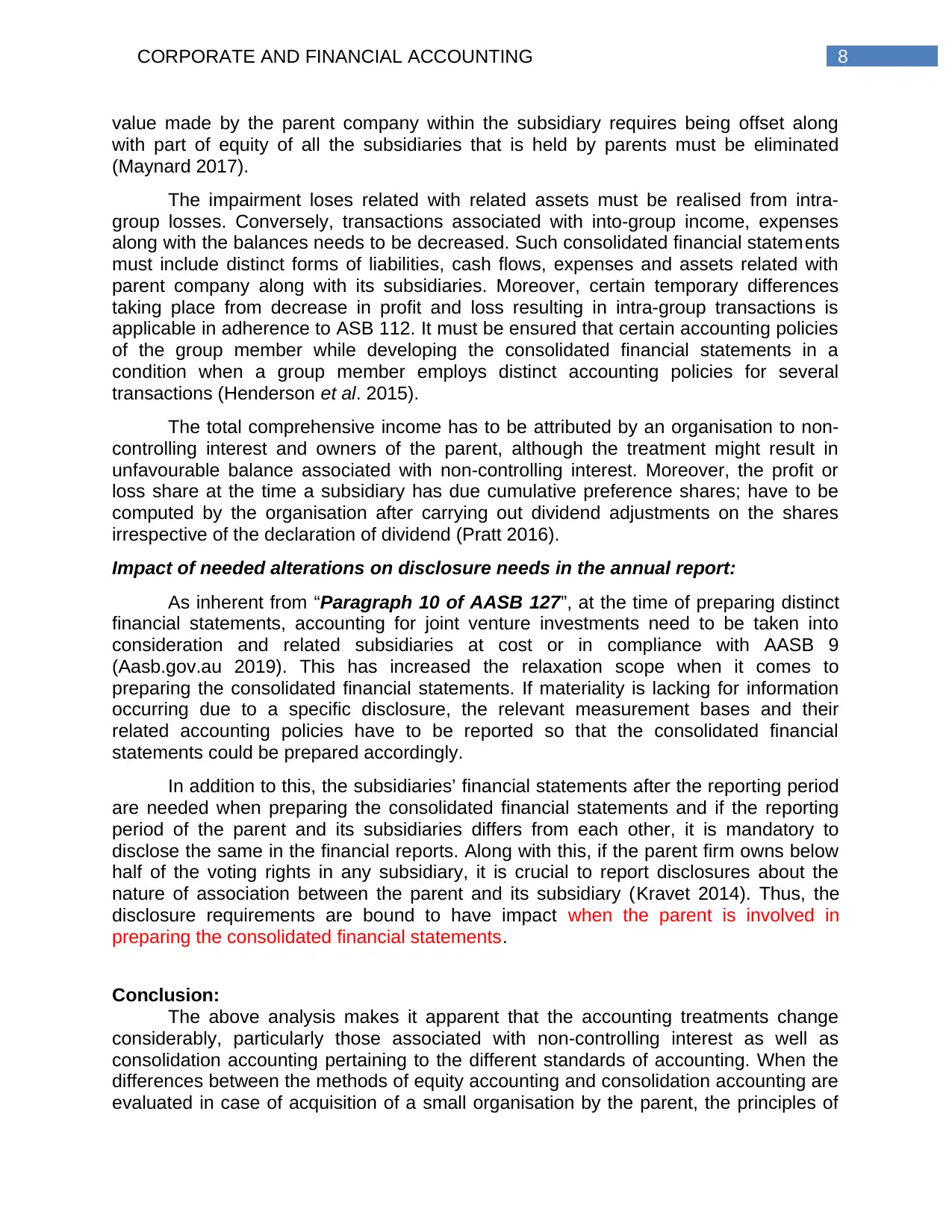
8CORPORATE AND FINANCIAL ACCOUNTING
value made by the parent company within the subsidiary requires being offset along
with part of equity of all the subsidiaries that is held by parents must be eliminated
(Maynard 2017).
The impairment loses related with related assets must be realised from intra-
group losses. Conversely, transactions associated with into-group income, expenses
along with the balances needs to be decreased. Such consolidated financial statements
must include distinct forms of liabilities, cash flows, expenses and assets related with
parent company along with its subsidiaries. Moreover, certain temporary differences
taking place from decrease in profit and loss resulting in intra-group transactions is
applicable in adherence to ASB 112. It must be ensured that certain accounting policies
of the group member while developing the consolidated financial statements in a
condition when a group member employs distinct accounting policies for several
transactions (Henderson et al. 2015).
The total comprehensive income has to be attributed by an organisation to non-
controlling interest and owners of the parent, although the treatment might result in
unfavourable balance associated with non-controlling interest. Moreover, the profit or
loss share at the time a subsidiary has due cumulative preference shares; have to be
computed by the organisation after carrying out dividend adjustments on the shares
irrespective of the declaration of dividend (Pratt 2016).
Impact of needed alterations on disclosure needs in the annual report:
As inherent from “Paragraph 10 of AASB 127”, at the time of preparing distinct
financial statements, accounting for joint venture investments need to be taken into
consideration and related subsidiaries at cost or in compliance with AASB 9
(Aasb.gov.au 2019). This has increased the relaxation scope when it comes to
preparing the consolidated financial statements. If materiality is lacking for information
occurring due to a specific disclosure, the relevant measurement bases and their
related accounting policies have to be reported so that the consolidated financial
statements could be prepared accordingly.
In addition to this, the subsidiaries’ financial statements after the reporting period
are needed when preparing the consolidated financial statements and if the reporting
period of the parent and its subsidiaries differs from each other, it is mandatory to
disclose the same in the financial reports. Along with this, if the parent firm owns below
half of the voting rights in any subsidiary, it is crucial to report disclosures about the
nature of association between the parent and its subsidiary (Kravet 2014). Thus, the
disclosure requirements are bound to have impact when the parent is involved in
preparing the consolidated financial statements.
Conclusion:
The above analysis makes it apparent that the accounting treatments change
considerably, particularly those associated with non-controlling interest as well as
consolidation accounting pertaining to the different standards of accounting. When the
differences between the methods of equity accounting and consolidation accounting are
evaluated in case of acquisition of a small organisation by the parent, the principles of
value made by the parent company within the subsidiary requires being offset along
with part of equity of all the subsidiaries that is held by parents must be eliminated
(Maynard 2017).
The impairment loses related with related assets must be realised from intra-
group losses. Conversely, transactions associated with into-group income, expenses
along with the balances needs to be decreased. Such consolidated financial statements
must include distinct forms of liabilities, cash flows, expenses and assets related with
parent company along with its subsidiaries. Moreover, certain temporary differences
taking place from decrease in profit and loss resulting in intra-group transactions is
applicable in adherence to ASB 112. It must be ensured that certain accounting policies
of the group member while developing the consolidated financial statements in a
condition when a group member employs distinct accounting policies for several
transactions (Henderson et al. 2015).
The total comprehensive income has to be attributed by an organisation to non-
controlling interest and owners of the parent, although the treatment might result in
unfavourable balance associated with non-controlling interest. Moreover, the profit or
loss share at the time a subsidiary has due cumulative preference shares; have to be
computed by the organisation after carrying out dividend adjustments on the shares
irrespective of the declaration of dividend (Pratt 2016).
Impact of needed alterations on disclosure needs in the annual report:
As inherent from “Paragraph 10 of AASB 127”, at the time of preparing distinct
financial statements, accounting for joint venture investments need to be taken into
consideration and related subsidiaries at cost or in compliance with AASB 9
(Aasb.gov.au 2019). This has increased the relaxation scope when it comes to
preparing the consolidated financial statements. If materiality is lacking for information
occurring due to a specific disclosure, the relevant measurement bases and their
related accounting policies have to be reported so that the consolidated financial
statements could be prepared accordingly.
In addition to this, the subsidiaries’ financial statements after the reporting period
are needed when preparing the consolidated financial statements and if the reporting
period of the parent and its subsidiaries differs from each other, it is mandatory to
disclose the same in the financial reports. Along with this, if the parent firm owns below
half of the voting rights in any subsidiary, it is crucial to report disclosures about the
nature of association between the parent and its subsidiary (Kravet 2014). Thus, the
disclosure requirements are bound to have impact when the parent is involved in
preparing the consolidated financial statements.
Conclusion:
The above analysis makes it apparent that the accounting treatments change
considerably, particularly those associated with non-controlling interest as well as
consolidation accounting pertaining to the different standards of accounting. When the
differences between the methods of equity accounting and consolidation accounting are
evaluated in case of acquisition of a small organisation by the parent, the principles of
⊘ This is a preview!⊘
Do you want full access?
Subscribe today to unlock all pages.

Trusted by 1+ million students worldwide
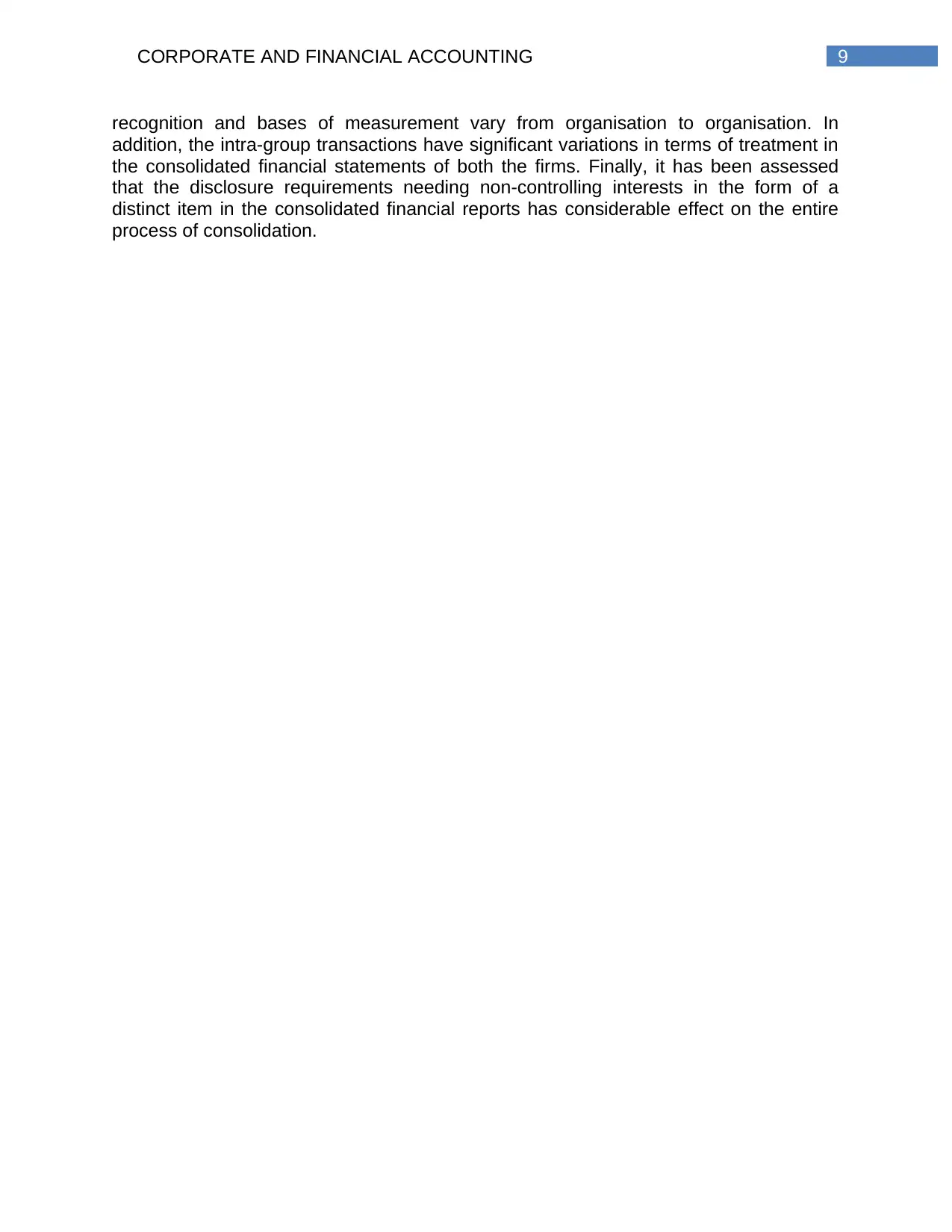
9CORPORATE AND FINANCIAL ACCOUNTING
recognition and bases of measurement vary from organisation to organisation. In
addition, the intra-group transactions have significant variations in terms of treatment in
the consolidated financial statements of both the firms. Finally, it has been assessed
that the disclosure requirements needing non-controlling interests in the form of a
distinct item in the consolidated financial reports has considerable effect on the entire
process of consolidation.
recognition and bases of measurement vary from organisation to organisation. In
addition, the intra-group transactions have significant variations in terms of treatment in
the consolidated financial statements of both the firms. Finally, it has been assessed
that the disclosure requirements needing non-controlling interests in the form of a
distinct item in the consolidated financial reports has considerable effect on the entire
process of consolidation.
Paraphrase This Document
Need a fresh take? Get an instant paraphrase of this document with our AI Paraphraser
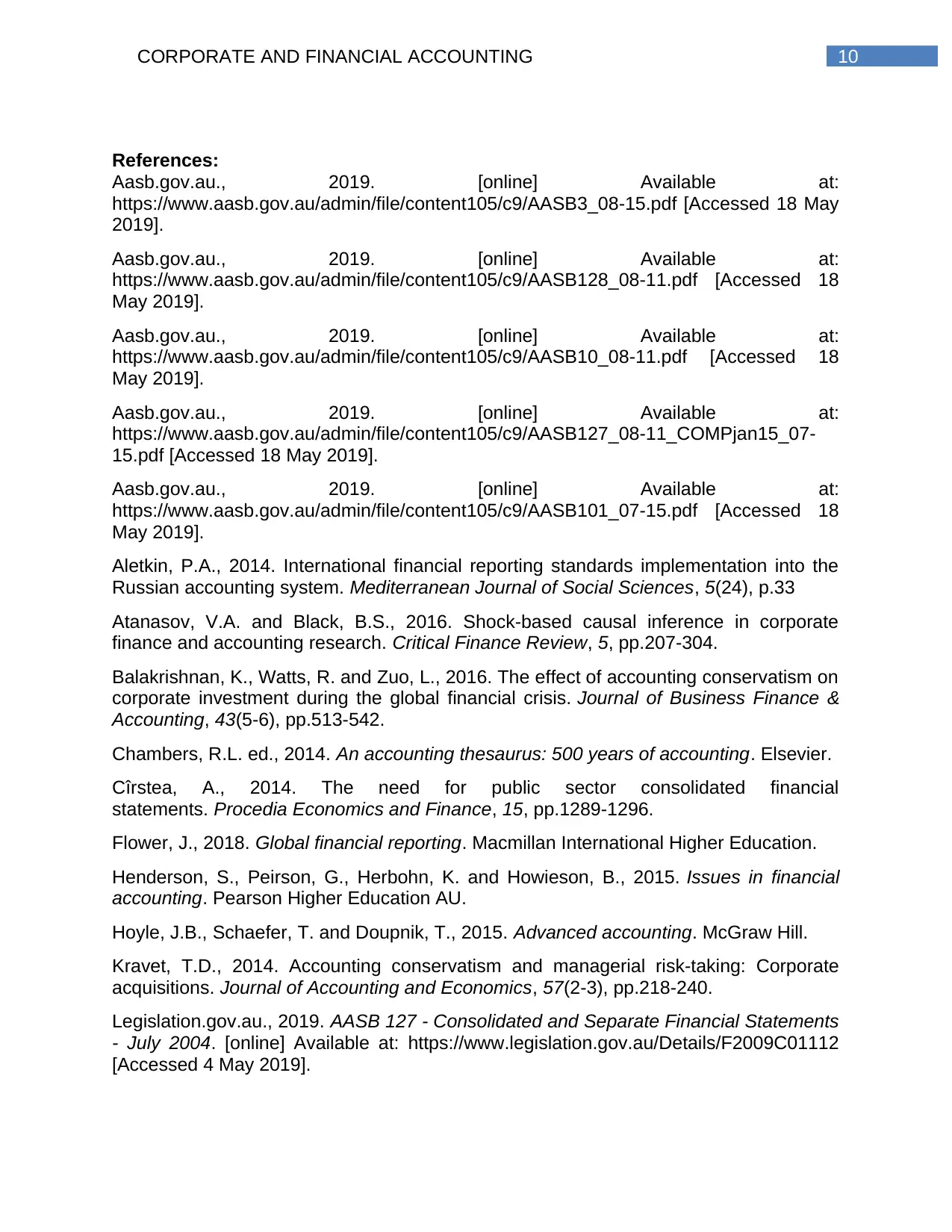
10CORPORATE AND FINANCIAL ACCOUNTING
References:
Aasb.gov.au., 2019. [online] Available at:
https://www.aasb.gov.au/admin/file/content105/c9/AASB3_08-15.pdf [Accessed 18 May
2019].
Aasb.gov.au., 2019. [online] Available at:
https://www.aasb.gov.au/admin/file/content105/c9/AASB128_08-11.pdf [Accessed 18
May 2019].
Aasb.gov.au., 2019. [online] Available at:
https://www.aasb.gov.au/admin/file/content105/c9/AASB10_08-11.pdf [Accessed 18
May 2019].
Aasb.gov.au., 2019. [online] Available at:
https://www.aasb.gov.au/admin/file/content105/c9/AASB127_08-11_COMPjan15_07-
15.pdf [Accessed 18 May 2019].
Aasb.gov.au., 2019. [online] Available at:
https://www.aasb.gov.au/admin/file/content105/c9/AASB101_07-15.pdf [Accessed 18
May 2019].
Aletkin, P.A., 2014. International financial reporting standards implementation into the
Russian accounting system. Mediterranean Journal of Social Sciences, 5(24), p.33
Atanasov, V.A. and Black, B.S., 2016. Shock-based causal inference in corporate
finance and accounting research. Critical Finance Review, 5, pp.207-304.
Balakrishnan, K., Watts, R. and Zuo, L., 2016. The effect of accounting conservatism on
corporate investment during the global financial crisis. Journal of Business Finance &
Accounting, 43(5-6), pp.513-542.
Chambers, R.L. ed., 2014. An accounting thesaurus: 500 years of accounting. Elsevier.
Cîrstea, A., 2014. The need for public sector consolidated financial
statements. Procedia Economics and Finance, 15, pp.1289-1296.
Flower, J., 2018. Global financial reporting. Macmillan International Higher Education.
Henderson, S., Peirson, G., Herbohn, K. and Howieson, B., 2015. Issues in financial
accounting. Pearson Higher Education AU.
Hoyle, J.B., Schaefer, T. and Doupnik, T., 2015. Advanced accounting. McGraw Hill.
Kravet, T.D., 2014. Accounting conservatism and managerial risk-taking: Corporate
acquisitions. Journal of Accounting and Economics, 57(2-3), pp.218-240.
Legislation.gov.au., 2019. AASB 127 - Consolidated and Separate Financial Statements
- July 2004. [online] Available at: https://www.legislation.gov.au/Details/F2009C01112
[Accessed 4 May 2019].
References:
Aasb.gov.au., 2019. [online] Available at:
https://www.aasb.gov.au/admin/file/content105/c9/AASB3_08-15.pdf [Accessed 18 May
2019].
Aasb.gov.au., 2019. [online] Available at:
https://www.aasb.gov.au/admin/file/content105/c9/AASB128_08-11.pdf [Accessed 18
May 2019].
Aasb.gov.au., 2019. [online] Available at:
https://www.aasb.gov.au/admin/file/content105/c9/AASB10_08-11.pdf [Accessed 18
May 2019].
Aasb.gov.au., 2019. [online] Available at:
https://www.aasb.gov.au/admin/file/content105/c9/AASB127_08-11_COMPjan15_07-
15.pdf [Accessed 18 May 2019].
Aasb.gov.au., 2019. [online] Available at:
https://www.aasb.gov.au/admin/file/content105/c9/AASB101_07-15.pdf [Accessed 18
May 2019].
Aletkin, P.A., 2014. International financial reporting standards implementation into the
Russian accounting system. Mediterranean Journal of Social Sciences, 5(24), p.33
Atanasov, V.A. and Black, B.S., 2016. Shock-based causal inference in corporate
finance and accounting research. Critical Finance Review, 5, pp.207-304.
Balakrishnan, K., Watts, R. and Zuo, L., 2016. The effect of accounting conservatism on
corporate investment during the global financial crisis. Journal of Business Finance &
Accounting, 43(5-6), pp.513-542.
Chambers, R.L. ed., 2014. An accounting thesaurus: 500 years of accounting. Elsevier.
Cîrstea, A., 2014. The need for public sector consolidated financial
statements. Procedia Economics and Finance, 15, pp.1289-1296.
Flower, J., 2018. Global financial reporting. Macmillan International Higher Education.
Henderson, S., Peirson, G., Herbohn, K. and Howieson, B., 2015. Issues in financial
accounting. Pearson Higher Education AU.
Hoyle, J.B., Schaefer, T. and Doupnik, T., 2015. Advanced accounting. McGraw Hill.
Kravet, T.D., 2014. Accounting conservatism and managerial risk-taking: Corporate
acquisitions. Journal of Accounting and Economics, 57(2-3), pp.218-240.
Legislation.gov.au., 2019. AASB 127 - Consolidated and Separate Financial Statements
- July 2004. [online] Available at: https://www.legislation.gov.au/Details/F2009C01112
[Accessed 4 May 2019].
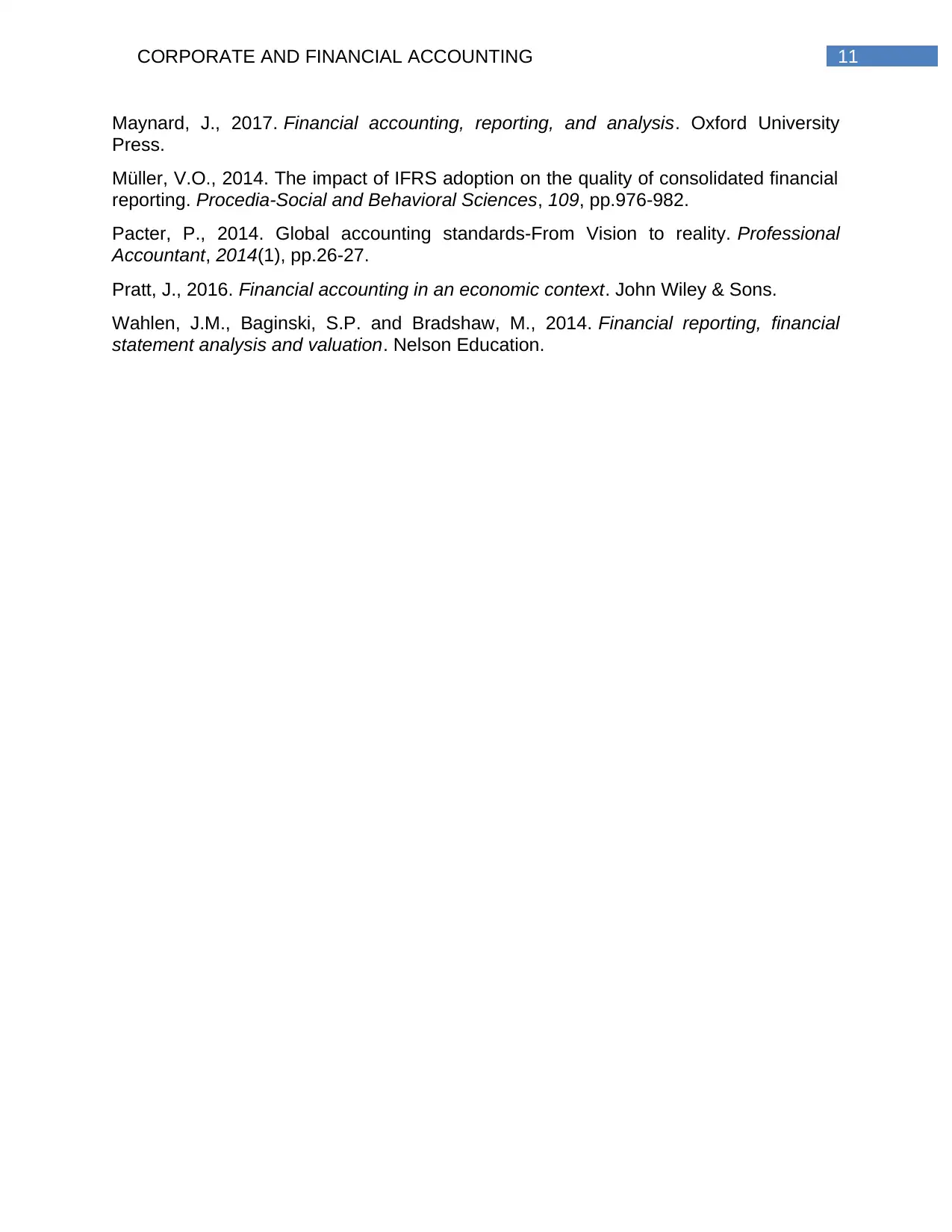
11CORPORATE AND FINANCIAL ACCOUNTING
Maynard, J., 2017. Financial accounting, reporting, and analysis. Oxford University
Press.
Müller, V.O., 2014. The impact of IFRS adoption on the quality of consolidated financial
reporting. Procedia-Social and Behavioral Sciences, 109, pp.976-982.
Pacter, P., 2014. Global accounting standards-From Vision to reality. Professional
Accountant, 2014(1), pp.26-27.
Pratt, J., 2016. Financial accounting in an economic context. John Wiley & Sons.
Wahlen, J.M., Baginski, S.P. and Bradshaw, M., 2014. Financial reporting, financial
statement analysis and valuation. Nelson Education.
Maynard, J., 2017. Financial accounting, reporting, and analysis. Oxford University
Press.
Müller, V.O., 2014. The impact of IFRS adoption on the quality of consolidated financial
reporting. Procedia-Social and Behavioral Sciences, 109, pp.976-982.
Pacter, P., 2014. Global accounting standards-From Vision to reality. Professional
Accountant, 2014(1), pp.26-27.
Pratt, J., 2016. Financial accounting in an economic context. John Wiley & Sons.
Wahlen, J.M., Baginski, S.P. and Bradshaw, M., 2014. Financial reporting, financial
statement analysis and valuation. Nelson Education.
⊘ This is a preview!⊘
Do you want full access?
Subscribe today to unlock all pages.

Trusted by 1+ million students worldwide
1 out of 12
Related Documents
Your All-in-One AI-Powered Toolkit for Academic Success.
+13062052269
info@desklib.com
Available 24*7 on WhatsApp / Email
![[object Object]](/_next/static/media/star-bottom.7253800d.svg)
Unlock your academic potential
Copyright © 2020–2026 A2Z Services. All Rights Reserved. Developed and managed by ZUCOL.




